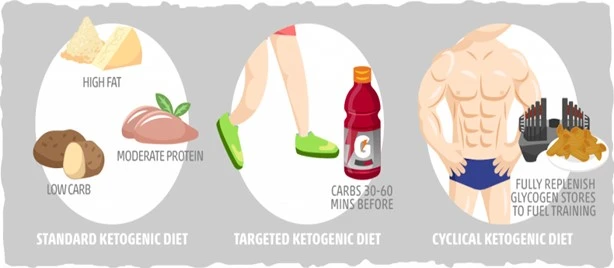Introduction
Are you tired of hearing about the same old boring diets that leave you feeling hungry and frustrated? Well, it’s time to spice things up with the ketogenic diet, the latest craze that’s taken Hollywood by storm. Kim Kardashian being a major proponent of the diet, it seems like every celebrity is swearing by the keto lifestyle to help them shed those extra pounds and get in shape.
But what exactly is the ketogenic diet, you ask?
It’s a high-fat, low-carb diet that encourages your body to enter a state of ketosis, where it burns fat for fuel instead of glucose. And trust me, it’s not as crazy as it sounds. In fact, it might just be the delicious and satisfying diet that you’ve been looking for.
But wait, there’s more!
Not all keto diets are created equal. There are different types of keto diets out there, each with its own unique approach and benefits.
So, whether you’re a fan of the glitz and glamour of Hollywood or the bright lights of celebrity world, there’s a keto diet out there that’s perfect for you.
So, let’s dive in and find out which one suits your lifestyle and preferences best!
What is The Ketogenic Diet?
Are you tired of diets that leave you feeling hungry and miserable?
Well, it’s time to shake things up with the ketogenic diet, or “keto” for short.
Picture this: you’re trying to lose weight, but no matter what you do, the pounds just won’t budge. You’ve tried every diet under the sun, but nothing seems to work.
Well, have you heard of the ketogenic diet?
The keto diet is a high-fat, low-carb nutritional approach that has taken the world by storm. From Kourtney Kardashian to Kim Kardashian, everyone seems to be hopping on the keto bandwagon. And it’s no wonder why – the keto diet allows you to eat all your favorite fatty foods while still shedding those stubborn pounds.
So, how does it work?
By restricting your daily carb intake to 5-10% of your caloric intake, you enter a state called ketosis, where your liver produces natural chemicals called ketones. These ketones burn stored body fat instead of glucose (sugar) as your primary energy source, which not only helps you lose weight on a ketogenic diet, but improves health, too.
But not all keto diets are created equal.
There are several different types of keto diets out there, each with its own unique approach and benefits.
Let’s go through them throughout this blog.
Why is Keto Diet Important?
If you’ve been searching for a diet that not only helps you shed unwanted pounds but also improves your overall health, then it’s time to give the ketogenic diet a closer look. This high-fat, low-carb eating plan is not just a fad, but a scientifically backed way to achieve your weight loss and health goals.
Not only can it help you shed those stubborn pounds, but it also boasts a myriad of health benefits that go beyond just the numbers on the scale.
But what exactly are the benefits of the keto diet?
- Well, for starters, research has shown that it can be incredibly effective for weight loss, and not just in the short-term.
But that’s not all.
- The keto diet has also been shown to improve blood sugar control and potentially reverse type 2 diabetes.
- Plus, it can improve your blood lipid profiles and may even prevent or improve the symptoms of diseases like cancer, Alzheimer’s, and epilepsy. In fact, the ketogenic diet was originally designed in the 1920s as a tool to treat epilepsy.
What Are the Different Types of Keto Diet?
There are different iterations of the keto diet. Three popular ones are:
- The standard ketogenic diet (SKD)
- The targeted ketogenic diet (TKD)
- The cyclical ketogenic diet (CKD)

The differences in each diet are explained below, as well as the goals of making modifications and who the diet might be useful for.
1. The Standard Ketogenic Diet (SKD)
The Standard Ketogenic Diet (SKD) is the OG amongst the different types of keto diets, and it’s the one that most people are familiar with. It’s a diet that’s low in carbs, moderate in protein, and high in healthy fats.
In other words, it’s a diet that encourages you to eat butter, cheese, and bacon – what’s not to love?
But what exactly does the SKD entail?
In a nutshell, it involves consuming 75% of your calories from fat, 20% from protein, and only 5% from carbs. This drastic reduction in carbs helps your body enter a state of ketosis, where it burns fat for fuel instead of glucose.
And the best part?
You get to indulge in all your favorite fatty foods, like avocados, nuts, and butter.
But you don’t have to be a celebrity to try out the SKD – anyone can give it a go and see how it works for them!
Potential Drawback
While the keto diet can have many benefits, it’s important to note that there can be potential drawbacks as well.
When transitioning to a keto diet, your body is used to running off glucose, so there is typically an adjustment period. During this time, many people experience symptoms like fatigue, dehydration, and what’s commonly referred to as the “keto flu.”
However, these symptoms usually subside after a week or two as your body becomes accustomed to using ketones as its primary source of energy.
2. The Targeted Keto Diet (TKD)
Are you someone who loves to hit the gym and pump iron? Do you ever feel like you’re not getting the most out of your workouts, even though you’re following a keto diet?
Well, the targeted ketogenic diet might be just what you need to take your fitness game to the next level!
So, what exactly is the Targeted Keto Diet?
Unlike the standard keto diet, which restricts carb intake to a minimum, the targeted keto diet allows for a small amount of carbs around your workout. This helps fuel your muscles during intense exercise and may improve performance.
The targeted keto diet typically involves consuming 25-50 grams of carbs before and/or after exercise, while still maintaining a high-fat, moderate-protein diet for the rest of the day. This ensures that you’re still in a state of ketosis, burning fat for fuel instead of carbs.
One famous celebrity who follows the targeted keto diet is none other than Hollywood heartthrob Chris Pratt. In preparation for his role in Guardians of the Galaxy, Pratt adopted a strict targeted keto diet and intense workout regimen.
The results?
A chiselled physique that had fans swooning!
Potential Drawback
Of course, there are benefits and drawbacks to this approach.
One potential drawback of the TKD is that it requires diligence to maintain ketosis. It’s important to be aware of your carb intake, especially if you’re consuming 50 grams of carbs before and after your workout. You may also have to limit your carb intake for the rest of the day, which could make sticking to the diet more challenging.
For instance, you may need to give up certain fruits, vegetables, or higher-carb nuts for much of the day.
If you struggle with maintaining self-discipline, then adhering to a TKD may be difficult for you. Despite its potential to improve your training, it may not be worth the effort if you find it too challenging to follow consistently.
3. The Cyclical Ketogenic Diet (CKD)
Are you an athlete looking to fuel your intense training sessions without straying from the benefits of the keto diet? Or maybe you want to indulge in a carb-heavy cheat meal occasionally, without throwing yourself out of ketosis.
Enter the cyclical ketogenic diet, or CKD.
As the name suggests, the CKD involves cycling between periods of strict keto and periods of higher carb intake. Typically, you’ll follow a standard keto diet for five or six days, then have one or two days of eating more carbs.
During the carb-up phase, you’ll consume between 150 and 600 grams of carbohydrates, depending on your activity level and body composition goals. This may seem like a lot compared to the 50 grams allowed on a standard keto diet, but it’s important to remember that this is still a controlled and planned phase, and the carb sources are typically whole, nutrient-dense foods.
The idea behind this type of Keto Diet – CKD is that the higher carb intake during the carb-up phase replenishes glycogen stores in the muscles and liver, providing energy for intense workouts and allowing for better performance. Then, during the low-carb phase, your body goes back into ketosis and burns fat for fuel.
One celebrity who has been known to follow the CKD is Hollywood actor and former bodybuilder Arnold Schwarzenegger.
In his book “The New Encyclopaedia of Modern Bodybuilding,” he describes a “cyclical diet” that involves alternating between five days of low-carb, high-fat eating and two days of higher carb intake.
Potential Drawback
While the CKD may be appealing to athletes and bodybuilders who crave carbohydrates, there are some potential drawbacks to consider.
One major consideration is that you won’t be in ketosis on the days when you eat more carbs. This means that your body won’t be burning ketones for fuel, which could slow down your weight loss or other health goals. Additionally, if you don’t exercise enough, it may take longer than a day to get back into ketosis. This could be frustrating for those who want to switch back and forth between burning carbs and ketones.
It’s important to note that the CKD may not even technically be a ketogenic diet if you’re not careful with your carb intake. So, while it may work well for some, it’s important to consider your individual goals and lifestyle before deciding to try the CKD.
Wrapping It Up
In conclusion, there are several types of keto diet, each with their own unique benefits and drawbacks.
The standard ketogenic diet, the targeted ketogenic diet, and the cyclical ketogenic diet all offer different advantages depending on your goals and lifestyle. Whether you’re looking to lose weight, improve your health, or increase your athletic performance, there’s likely a keto diet variation that will work for you.
So why not give it a try?
You never know, you might just end up feeling better than ever before. And who knows, maybe you’ll even feel like Tom Hanks in Cast Away when he finally starts that fire on the beach after being stranded for so long.
But in all seriousness, if you do decide to try the different types of keto diet, make sure to do your research and consult with a healthcare professional.
And if you’re already a keto veteran, let me know which variation has worked best for you and why.



